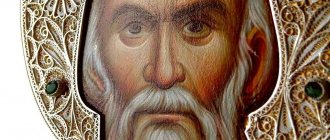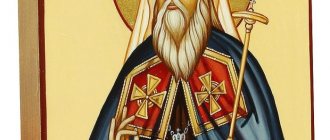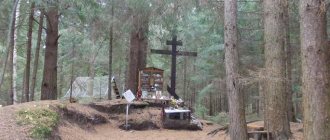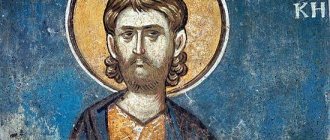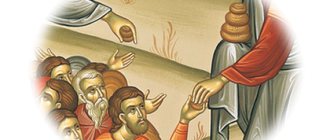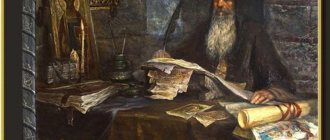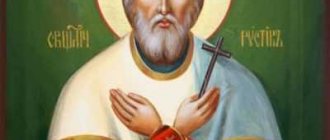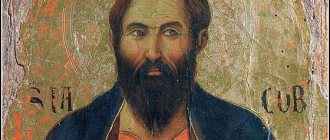Life of Saint Julian of Kenomania
Civitas Cenomanorum is the ancient name of the French city of Les Maines, the administrative center of the Sarthe department (northwestern region of France). The region was part of the Roman Empire. The Gauls who lived in this territory professed paganism, worshiping Zeus, Jupiter and other gods of the Romans.
The apostles, fulfilling the covenant of Jesus Christ, carried the Word of God to the pagans, converting them to the true faith. The Apostle Peter preached in many countries. His companion was Julian (before baptism, Simon was a leper, who believed in Christ after being cured). Peter sent Julian to preach the Gospel in Gaul, appointing him bishop.
Upon arrival in Kenomania, Julian settled outside the city, in a desert area in a small hut. The local population treated the bishop with distrust and ridicule. The saint often accompanied his sermons with miracles of healing. While healing bodies, he also healed souls, enlightening the pagans with the Sacrament of Baptism. Those suffering began to come to his house for help.
There was no river or well near the preacher's house, and people often suffered from thirst. One day, after praying to the Lord, the saint stuck a rod into the ground, and a spring gushed out of it. The believers present were strengthened in Christianity, and the pagans fell at the feet of Julian asking him to baptize them. Miracles convinced people of the truth of Iulin's words about God. Near his source, he baptized them into the faith of Christ.
The ruler of Kenomania wished to see the saint. At the princely gates, Julian saw a blind man and took pity on the unfortunate man. Having offered a prayer to the Lord, he overshadowed the eyes of the blind man. The man who had regained his sight could not come to his senses from joy. The prince was informed about what had happened, and he hurried to meet the preacher of the Word of God. The ruler turned to the bishop with a request to baptize the entire family. The prince donated his house and funds for the construction of the temple. Following his example, many noble people of the city converted to Christianity, also making generous donations to the church.
The saint equipped the church and began to preach the Gospel, not forgetting to confirm the power of the Christian faith with miracles. One day, a noble Cenomanian, who did not believe the bishop’s sermons, came to him and with tears began to beg in the name of Christ to revive his deceased beloved son. Julian told him that if he believed in Jesus Christ, his son would live. The Kenomanite swore that he would renounce idolatry and believe in Christ if his son was reborn to life. The bishop and the deacon went to his home, and through his prayer the boy was resurrected.
The fame of Saint Julian spread throughout Gaul. The saint walked from village to village, comforting and healing the sick, and bringing the dead back to life.
Fervent prayers and renunciation of idolatry followed in the footsteps of the bishop. Through his prayer, those possessed by demons recovered. The Kenomanian country believed in Christ with the exception of some of the most ardent idolaters. Upon returning to his city, the saint heard prisoners from prison calling to him asking for release.
The servant of God took pity on them and appealed to the judges to have the prisoners released from prison, but was refused. Grieving for the unfortunate, he went to church and offered a prayer of gratitude to the Lord, who gave him the power to heal and resurrect people in the name of saving souls. But he was saddened by the inability to alleviate the plight of the prisoners. The Lord sent an Angel at night who freed the prisoners. The guards did not dare to detain them, as they saw that the liberation happened by God's will. The prisoners went to the house of the bishop, who, seeing the prisoners free, invited them to his house, fed them and sent them home.
Julian lived to a ripe old age, remaining the spiritual mentor of the flock of the Kenomanian country. A few days before his death, he left the city for another village, where he fell ill. Concerned about the state of his health, clergy and believers who especially revered him came to him. The bishop appointed his successor, blessed everyone and gave his soul to God.
Born in 1597. He labored as a feat of fasting under the altar of the monastery cathedral, where he was buried. When the veneration of St. Basil and St. Julian was established, it is no longer possible to say, but the two of them included troparia and kontakia in the chronicle of the Murom Cathedral of 1725. Under the floor of the Annunciation Church, which is supported on vaults quite high from the ground, in ancient times, most likely, there was a tomb for the monks of the monastery. In 1834 (according to archival sources in 1831), the tomb with the incorruptible relics of St. Julian was opened by workers who were building new vaults for the Annunciation Cathedral. Under the floor they found a stone slab with the inscription: “In the summer of March 7146 (1638), on the 26th day, the servant of God, the schema monk Iuliyan Fedorov, son of Kuchukov, passed away.” Soon the completely intact coffin of this schema-monk was found. Out of curiosity, the workers opened the lid of the well-preserved coffin and, seeing the shoes and clothing of the deceased, were frightened. They reported their discovery to the priest Simeon Berezin, who was then serving as treasurer in the monastery. The priest Simeon, reaching out his hand into the hole of the coffin, felt the preserved body of the deceased. Frightened in turn, he ordered the workers to bury the coffin in the ground again and not tell anyone about what had happened. After some time, according to eyewitnesses, a woman came to the monastery and began to ask to serve a memorial service over the tomb of Schemamonk Julian, who allegedly appeared to her in a dream and healed her of her illness. It was then that priest Simeon decided to reveal the secret of the burial to the abbot of the monastery and indicate the location of the schemamonk’s tomb. From that time on, many began to come and serve requiem masses over the tomb of St. Julian. A valuable addition and clarification to this presentation by Archimandrite Misail is the Chronicle of the Annunciation Monastery. It includes the story of the eyewitness of this event, priest Simeon Berezin, with confirmation of the reliability and authenticity of the archimandrite of the Pereslavl Nikitsky Monastery Nifont, who for several years was the rector of the Annunciation Monastery (1843-1845) and personally tonsured the priest Simeon Berezin into monasticism with the name Serapion and admonished him on eternal life. This is how Archimandrite Nifont described this event from the words of Fr. Simeon: “The masons were digging a ditch for the arch, they took out a slab from the ground with some kind of inscription, on which, after removing a very insignificant layer of earth, they found a completely intact coffin and almost new, which, since it had a third of its length in the ground, out of their reckless curiosity, they knocked off a corner of the lid and, seeing the robe and brand new shoes in it, they became afraid and told this priest Berezin, who was then walking from the temple, who, going down to the coffin and grabbing his leg with his hand, shook it, and felt that the whole body was intact and everything was swaying with shaking his leg, from which he ran away in fear, ordering that the broken thing be laid again and covered with earth, without ordering him to tell anyone; After quite some time, and even about six months, a woman came from a distant village, who had been healed in a dream vision from an illness that had lasted for a long time and received orders from the one who healed her to go to the Murom Annunciation Monastery and serve a requiem mass over the tomb of Schemamonk Julian. When she asked to show her the burial place of this schema-monk, due to the unknown, no one could show her. And she went to Father Hegumen Procopius and asked him to at least serve her a memorial service for him and that the very priest who shook this saint by the leg would serve, as she was ordered by the one who healed her, then asked all the hieromonks and priests. Priest Berezin admitted his insolence and, indicating the place under the Annunciation Church, served a memorial service. After which, having cleared the inscription on a stone taken out of the ground, they made sure that it was Schemamonk Julian who was resting here, and from that time on, those who came began to serve memorial services and receive healings.” The unexpected discovery of the incorruptible relics of Schemamonk Julian in the basement of the monastery church occurred on October 8, which is indirectly evidenced by the decree of the ruling Vladimir bishop from the diocese, and Bishop Jacob (Krotkov) directly points to the same date in his letter to the treasurer of the Annunciation Monastery. A stone slab with a detailed inscription about him was placed on the tomb. Prayers began to be held in the temple and on March 26 to celebrate his memory as a locally revered saint. However, over time, veneration of the saint’s memory was erased from the people’s memory. In the same 1831, due to the dilapidated state of the roof of the Church of St. John the Theologian, work was undertaken to replace it. The new roof and porch of the temple were painted green. In his report in November 1879, the treasurer of the monastery, Hieromonk Simeon, asked the abbot for permission to build a chapel equipped with an iconostasis at the site of the exploits of Schemamonk Julian (in the basement of the Annunciation Church). Bishop Jacob writes an evasive answer to this on December 13: “...I find the iconostasis under the church inconvenient, firstly, because there is no particular need; secondly, because the new throne will require security, but this is not meant. I said before that I would agree to this when not only the construction of the chapel, but also its repair and heating would be immediately provided... An obstacle to this seems to be the fact that there are no windows below (the bishop meant large windows), and breaking through is unlikely Will they allow it? Our temple is ancient. Here's what you can do, if there are zealots for Schemamonk Julian, who died in Bose, from March 26, 1638 (240 years old), paint an icon of his Angel - the holy martyr like Emissa, in Phenicia Julian - a doctor (February 6) and place it at the grave good icon case with the approval of the annual prayer service to the holy martyr after the liturgy on the 6th day of February, and on March 26, on the day of death and October 8, on the day of the opening of the tomb of the blessed Schemamonk Julian, to serve the funeral liturgy and then at his grave a cathedral requiem service. It is I who will order it to be painted in the Diveyevo Hermitage, send me only the measure of this icon in the place where it should be placed. What can be done under the church to improve it, give me ideas, what it will cost and who will bear the costs.” Apparently, this refusal of the abbot had a depressing effect on the brethren of the monastery, and he did not respond to the bishop’s proposal. Therefore, Bishop Jacob wrote in his next letter to the brethren of the monastery, as if reproachfully: “Why don’t you write anything about the icon of the martyr Julian? I thought to make it by February 6, but you... (didn’t send the sizes needed for it). In order not to waste time, order an icon from Murom painters and ask them to have it ready by February 1st. Write it like this: in the middle is the martyr Julian in full height, on top is Archangel Michael, and on the sides are Gabriel and other angels. The arrangement of the icon is submitted to the zeal of the readers, who are required to declare it.” But apparently, the brethren of the monastery did not take any action on this. Moreover, the treasurer of the monastery was changed, Hieromonk Simeon was transferred to another monastery (perhaps for disobedience to the abbot). Hieromonk Simeon was replaced by Hieromonk Innocent. In the end, tired of waiting, Bishop Jacob himself orders the painting of the icon. In the next letter to the monastery dated May 8, 1880, he writes the following about this: “Soon the icon of the holy martyr Julian will come to you. It will be necessary to arrange a shrine for her. The height of the icon is 13/4 arshin (approximately 1 m 25 cm), and the width is 5 (quarters?). Are there people who are zealous for this?” In June, the icon was delivered to the Annunciation Monastery and placed in its designated place. Hieromonk Innocent took care of making a good icon case for her. In the subsequent monastery inventory of church property, the following will be reported about this icon placed in front of the tomb of Schemamonk Julian: “The icon, built in 1880 by willing donors, is picturesque, depicting the holy martyr Julian, small in size, with an image on the top of the Mother of God and the seven ranks Arkhangelsk. The icon is in an icon case behind glass with gilded carvings around it.” In the crypt (the room was originally used as a fraternal burial vault) there is a wooden shrine, on the front side of which there is an iconographic image of the monk, which records the approximate burial place of the holy ascetic Schemamonk Julian (Kuchukov). Vasily Nikolsky was ordained a priest at the end of March 1920 and assigned to serve in the Annunciation Church. When Fr. Vasily in July 1933, with the blessing of the Deputy Patriarchal Locum Tenens Metropolitan Sergius, in the basement of the Annunciation Cathedral, the relics of Schemamonk Julian (Kuchukov) were opened and examined. They remained intact until this time. The monastic clothes of the saint turned out to be almost completely undecayed, except for some of them. Even a ladder was found in the schema-monk’s hand, which was in a damaged condition. From that time on, in the Annunciation Church, with the blessing of Metropolitan Sergius (Stragorodsky), the names of St. Basil of Murom and St. Julian began to be lifted up during services with other Murom saints. A new icon was created in icon painting - the Cathedral of All Murom Saints.
Icon of the Cathedral of Murom Saints. 1996 Icon painter I.V. Sukhov
Memory: March 26 / April 8 Beginning »»» Hegumen of the Annunciation Monastery Sergius (1563-1625).
Hegumen of the Annunciation Monastery Theodosius I (1625-1636)
The period of abbotship of Abbot Theodosius (1625-1636) passed under the patronage and paternal care of the Annunciation Monastery of the Tsar and Grand Duke Mikhail Feodorovich. According to his royal charter, dated November 30, 1625, the reapings of the Veletemskaya River were written to the Abbot and his brethren for candles, incense, and church wine, and the border of that river from the mouth of Poglinitsa, and to that dacha there was that river for rent for Murom resident Semyon Cherkisov." Hegumen Theodosius himself died in 1636, having, before his death, been tonsured into the great schema with the name that he bore before becoming a monk - Filaret.
Hegumen of the Annunciation Monastery Joachim (1636-1650)
Then the Annunciation Monastery was ruled by Abbot Joachim (1636-1650), who on June 20, 1647, due to the depletion of funds to maintain the monastery, petitioned Tsar Alexy Mikhailovich. A valuable description of the monastery, compiled under this abbot in 1637, has been preserved. It allows us to fairly accurately imagine what the monastery looked like then. The monastery lands under the buildings and cemetery were 60 fathoms long (127.8 m), 50.5 fathoms wide (107.5 m), and in its total area extended approximately 1000 square meters. m. In size, the Annunciation Monastery was almost twice as large as the Murom Spassky Monastery. The monastery fence was made of oak wood. He had his own garden. Inside the monastery there was a stone Annunciation Cathedral and three wooden churches, which were already mentioned in 1616 in the petition of Abbot Sergius: St. Apostle John the Theologian (with a refectory), St. Gregory the Theologian and the gate church of St. Apostle Archdeacon Stephen. Near the temples there were 14 fraternal cells and the cell of Abbot Joachim. The descriptions of the monastery churches are especially interesting. In the Church of the Annunciation in 1637 there were 10 icons, 3 of them in a silver frame. The interior of the church was decorated with a tyablo iconostasis. “The royal doors and the canopy and the columns are on gold,” that is, written on a gold background. Also, icons of the Deesis, prophetic and forefathers orders were made “on gold”. In front of the Deesis row of the iconostasis there was a copper chandelier. Here in the temple, as the main monastery shrine, rested the holy relics of the Murom wonderworkers of the blessed Prince Constantine, Princess Irina and their children Mikhail and Theodore, as well as the latter’s son, Theodore (the younger). In those years the monastery was quite rich. Being under the patronage of the royal dynasty, the monastery regularly received rich contributions and donations. Thus, in the inventory of church supplies one often encounters things decorated with silver and gold: icons, liturgical vessels, vestments and other church utensils. Another eloquent fact speaks about the wealth of the monastery: a large number of liturgical books - 43. Compared to the inventory of 1624, 8 books were added. At that time, books were very expensive (the price of a book was equal to the price of a village with its inhabitants). The decoration of other churches of the Annunciation Monastery was no less rich. “Yes, in the same monastery,” says the Scribe Book of 1637, “the Church of Ivan the Theologian with a refectory, wooden; and in it of God's mercy there is a local image of Ivan the Theologian on gold, an image of the Intercession of the Most Pure Mother of God on gold, an image of the great martyr Paraskeva called Friday, an image of the Most Pure Mother of God the Burning Bush - both on green. The royal doors and the canopy and columns are on gold...” The Church of St. Gregory the Theologian was of interest for its construction: “...and a bell tower was attached to the same church.” At that time there were 6 bells on the belfry. It has already been said above that the Annunciation Monastery existed mainly due to donations from influential persons of the royal family. Confirmation of this can be found in the same Scribe Book for 1637: “And in the stone and wooden Church of God’s Mercy there are images and candles and books and vestments and coverings and church vessels and on the bell tower there are bells and all the church buildings of the former kings and the Tsar and Grand Duke Mikhail Feodorovich of All Rus'." Next to the wooden monastery fence there was a small settlement. It was inhabited by bobyli (landless townspeople) who worked for the monastery. The year of foundation of the settlement is documented - 1585. In 1616, the settlement suffered greatly from the raid of Lisovsky’s gang. In 1637, there were 22 residential courtyards and one empty courtyard in the settlement. 24 people lived in them. At that time, only males were subject to description. Thus, in the 40s. XVII century About fifty people lived in the settlement. In comparison with the inventory of 1624, the number of Bobyl residential courtyards increased by 6. Among their inhabitants were artisans and tradesmen of the following specialties: berdnik (armourer), silversmith, carpenter, brewer, seine operator, dyer, hat maker, yaryzhka (laborer) in one yard each and two courtyards each of tailors, icon painters and shipyards (barge haulers). The inhabitants of the Annunciation Monastery were in a privileged position. Since ordinary townspeople were obliged to pay duties to the state treasury and perform all kinds of duties (police, prison, coachman and many others), Sloboda residents were exempt from all this. The only dependence on the monastery was rent - 2 hryvnia per yard (20 kopecks). The entire quitrent amount is 4 rubles 13 altyns, 2 money. The right to collect rent is also a kind of royal gift to the monastery. Persons from eminent princely families did not remain aloof from charitable generosity. Thus, in 1639, the Annunciation Monastery received a contribution from Prince Dimitry Mikhailovich Pozharsky - a water-blessing cup made of red copper, coated with silver. “Its size in diameter is 11 vershok (44 cm), depth 3S vershok (12 cm), around it, from the outer edge, there is an inscription carved: “On July 16, 7147 (1639), this holy cup of water was sacred and the most pure Annunciation was placed in the house The Mother of God and the Murom miracle workers of the blessed Prince Kostyantin and the child and Prince Mikhail and Theodore, that in Murom at the posad, the boyar Prince Dmitry Mikhailovich Pozharsky for his health and for his departed (on the side of the bowl) parents endless eyelids (at the bottom at the foot) under Abbot Joachim and his brothers.” In 1638, the brethren of the Annunciation Monastery, led by Abbot Joachim, saw off the venerable ascetic of the monastery, Schemamonk Julian (Kuchukov), who was buried in the basement of the Annunciation Church. Summing up the property status of the Murom Annunciation Monastery, we note that in the 1630s. in socio-economic terms, the monastery occupied one of the leading places in the city, not much inferior to the Cathedral of the Nativity of the Virgin Mary and the Spassky Monastery. Only in 1630 was the further position of Abbot Joachim determined: he was transferred to the Murom Spassky Monastery.
Abbot of the Annunciation Monastery Savva (1646)
By 1646, no significant changes had occurred in the monastery. On the territory of the monastery, four churches still stood (a stone one in the name of the Annunciation of the Blessed Virgin Mary and three wooden ones). Next to them were 14 fraternal cells. The abbot of the monastery was Abbot Savva (1646), who temporarily replaced Abbot Joachim. At the end of the 50s. XVII century under the walls of the Annunciation Monastery, the monastic settlement lived out its last years (in 1649, by royal decree, its inhabitants would be transferred “to the settlement” - this is discussed below). There were 22 courtyards in it - the same number as in 1637, and the number of its inhabitants has almost doubled. If in 1637 there were 24 men, then in 1646 there were 59. Consequently, shortly before the liquidation of the settlement, at least a hundred people lived in it. Despite the significant increase in the population of the settlement, no major changes occurred in terms of crafts.
Comparative table for the inhabitants of the monastic settlement for 1637 and 1646
As can be seen from the table, in 1646 the settlement stopped making weapons (which may well be explained by the absence of an external military threat), fishing gear, hats, painting canvases, but such a peaceful and a necessary profession as a baker who makes baked goods for sale. Of course, it is impossible to draw any solid conclusions from the table above - this requires the use of more extensive material. A special section from the life of the Annunciation Monastery is the icon-painting workshop, which emerged around the same time: “a monastery settlement, and in it the courtyards of priests and church and trade and craft and working people and peasants... Yes, from their yards and from the land they give rent in monastery..., in the courtyard Ivashka Savvin is an icon-maker, he has a ten-year-old son Ivashka; in the yard of Volodymerko Panfilov is an icon maker, he has children Stepashko and Ofonka and Ivashka, nine years old. And for the rent they paint images of miracle workers and take those images to the sovereign, just as an abbot travels with a shrine.” “The icon painters Ivashka Savvin and Volodka Panfilov lived at the Annunciation Monastery in the settlement (modern Krasnoarmeysky Lane). A very important fact is that both of them were considered nobles of the Annunciation Monastery, that is, they were considered impoverished feudal-dependent people. And the payment of the quitrent was carried out by them by painting icons. The skill of the Murom icon painters Ivashka Savvin and Volodka Panfilov was so great that the icons they painted were specially taken to Moscow to the royal palace. Perhaps the future famous icon painter Alexander Ivanovich Kazantsev was born in one of these two mentioned families in 1658. Already at the age of twenty he became known as a master of icon painting. His younger brother Theodore, later his son Peter, worked with him. The Kazantsev dynasty lived and worked at the Annunciation Monastery throughout the 17th century. and until the last quarter of the 18th century." In 1649, an important historical document was adopted, regulating all legal and legal relations of the Russian state - the Council Code. According to Chapter 19 of the Code, monasteries were deprived of settlements - “with all the people, with the lands.” Naturally, the Annunciation Monastery shared the same fate along with other monasteries in Russia. He lost an important source of income. However, despite the severity of the royal decree, the monastery still owned a number of courtyards. This revealed the half-heartedness of the tsarist reform, when households were supposedly transferred to a tax-paying position in posads, but in fact, often everything remained the same. So it was with the Annunciation Monastery. According to the Salary Book of 1676, the monastery owned fourteen township and three bobyl courtyards, charging them 12 altyns annually. Continued »»» Murom Annunciation Monastery from 1650 to 1771 Holy Annunciation Monastery State of the Murom Annunciation Monastery in 1906 Vladimir Diocese.
Prayer
O most honorable and sacred head and filled with the grace of the Holy Spirit, the abode of the Savior with the Father, great bishop, our warm intercessor, Saint Julian! Standing at the Throne of all the King and enjoying the light of the consubstantial Trinity and cherubically with the Angels proclaiming the Trisagion hymn, having great and unexplored boldness towards the All-Merciful Master, pray for the salvation of Christ's flock people, establish the well-being of the holy Churches, adorn the bishops with the splendor of holiness, monastics to the feat of goodness strengthen the flow , preserve all cities and countries with goodness, and beg to keep the holy immaculate faith, pacify the whole world through your intercession, deliver us from famine and destruction, and save us from the attacks of foreigners, console the old, instruct the young, make the foolish wise, have mercy on widows, protect orphans, and babies grow up, return the captives, free those who are weak and pray to you from all misfortunes and troubles through your intercession. Pray for us to the All-Bountiful and Humane-loving Christ our God, so that on the day of His terrible coming He will deliver us from this evil state, and create eternal joy as partakers with all the saints forever and ever. Amen.
